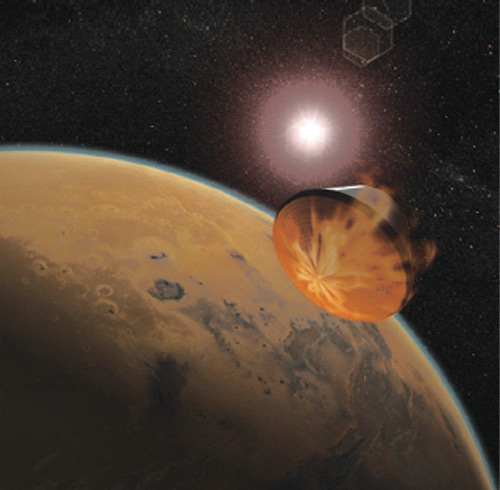Redesigning Rockets: NASA Space Propulsion Finds a New Home

While the exploration of the Moon and other planets in our solar system is exciting, the first task for astronauts and robots alike is to actually get to those destinations.
To facilitate inter-solar system travel, NASA has committed itself to the study of a number of far-out propulsion methods. Researchers are hoping the space agency's new Propulsion Research Center will help scientists move at least some of those new methods from the theoretical to reality.
"We need a real jumpstart in propulsion and research," said Steve Rodgers, manager of the new center based at NASA's Marshall Space Flight Center (MSFC) in Huntsville, Alabama. "I think we have to go beyond chemical propulsion."
Most NASA spacecraft rely on some form of chemical propellant to push themselves through space. But at the Marshall-based center researchers are studying a range of future propulsion methods, including propellant-less systems, simulated fission engines that could one-day lead to the real thing and the basic technologies necessary for future antimatter drives.
"I think our real vision is to really look at some new ideas for propulsion, and bring to the table some new concepts to make them more accessible," Rodgers told SPACE.com.
With 26 laboratories and 66,000 useable square feet to work with, Rodger's propulsion facility will serve as a hub for engineering and scientific research for future missions, he added.
Space travel sans propellant
Breaking space news, the latest updates on rocket launches, skywatching events and more!
Among the more promising future propulsion technologies is aerocapture.
Much like aerobraking, which a number of NASA spacecraft including Mars Odyssey have used to slow themselves upon arriving at their target worlds, aerocapture is intended to allow a spacecraft use a planet's atmosphere to alter its flight trajectory. But where aerobraking requires multiple orbits and repeated burns by a spacecraft's engine, aerocapture is expected to put a vehicle in orbit after one pass without consuming one drop of fuel.
"With aerocapture, it's done all at once," explained Les Johnson, manager of NASA's In-Space Propulsion Technology Projects Office at MSFC. "You have a heat shield...you do the maneuver, and in 30 minutes you're in a circular orbit."
Letting a planet's gravity and physics direct a spacecraft could save about 40 percent of mass in propellant that would be better spent on scientific instruments, Johnson told SPACE.com.
The engineering foundation for an aerocapture system - in terms of ablative materials, thermal protection systems and navigation control - are not unknown technologies, and a potential test vehicle could be ready in about two years, researchers said. In addition to a standard cone-shaped aeroshell approach to aerocapture, scientists have also looked using a protective nose ballute, and even dragging an inflatable, donut-like ballute behind a spacecraft during the flight maneuver.
"It's a matter of putting it all together and it all looks pretty doable," Johnson said, adding that the method is primary targeted for robotic missions. "There is a benefit to human exploration for aerocapture, from an incremental technology point of view."
Other options
Johnson said his group is pursuing aerocapture along with two other propulsion methods - solar sails and the next generation of ion engines - in parallel to offer mission designers a choice of flight options to suit spacecraft needs. The team has already successfully deployed two, 33-foot (10-meter) solar sails in a vacuum chamber.
Meanwhile, researchers with both Johnson's team and the Marshall-based propulsion center are exploring tether-based technologies to swing spacecraft on their way. The spinning Momentum eXchange/Electrodynamic Reboost (MXER) tether, for example, could sling spacecraft into higher orbits or out on interplanetary trajectories without the need for pesky - and heavy - upper stages.
"It's definitely high-risk [now]," Johnson said, adding that he doesn't envision such a system lobbing people into space anytime soon. "It's maybe 10 to 15 years out."
Going nuclear
Researchers at the agency's new propulsion research center are looking at approaches for fission-based nuclear engines to power tomorrow's spacecraft.
Using specialized, non-radioactive heaters to simulate fission reactors, propulsion engineers are evaluating different ways of converting heat from a reactor to power an ion engine or gas-based thrusters.
"They are all on about the same power levels," said Melissa Van Dyke, testbed manager early flight fission test facility at the propulsion center, in a telephone interview. "The delineation is basically how you take heat out of the core."
An effective fission system could provide up to 10 million times the energy density generated by the chemical reactions employed on NASA's space shuttles, with one soda can of uranium matching the power of 100 shuttle external tanks. A nuclear reactor is slated to power the electric propulsion system for the Jupiter Icy Moons Orbiter (JIMO) under the space agency's Project Prometheus, said Michael LaPointe, NASA's high-power propulsion research manager at MSFC
Researchers are also studying the possibility of bending high-powered plasmas, electrically charged gas, to their propulsion whims. In addition to developing plasma-based engine systems, the charged gas itself may be used to generate extremely high energy levels that could lead to fusion propulsion systems, researchers said.
"Fusion systems are going to be fairly large," Rodgers said, adding that while research into the method continues, a practical system is still years away. "It needs to produce more energy than it takes to make it work and we're note there yet."
Handling antimatter
On the more extreme end of NASA's propulsion research are studies to wield antimatter in future space engines.
The collision between particles of normal matter and antimatter - such as protons and their oppositely charged antiproton counterparts - produces the most energetic reaction known in physics, but handing the explosive stuff is the hard part. Researchers at the MSFC propulsion center are working with tiny amounts of antimatter to find effective ways of storing and transporting the stuff for space voyages.
"The antimatter research is certainly far term," LaPointe said. "You need to start somewhere...to make baby steps."

Tariq is the award-winning Editor-in-Chief of Space.com and joined the team in 2001. He covers human spaceflight, as well as skywatching and entertainment. He became Space.com's Editor-in-Chief in 2019. Before joining Space.com, Tariq was a staff reporter for The Los Angeles Times covering education and city beats in La Habra, Fullerton and Huntington Beach. He's a recipient of the 2022 Harry Kolcum Award for excellence in space reporting and the 2025 Space Pioneer Award from the National Space Society. He is an Eagle Scout and Space Camp alum with journalism degrees from the USC and NYU. You can find Tariq at Space.com and as the co-host to the This Week In Space podcast on the TWiT network. To see his latest project, you can follow Tariq on Twitter @tariqjmalik.
